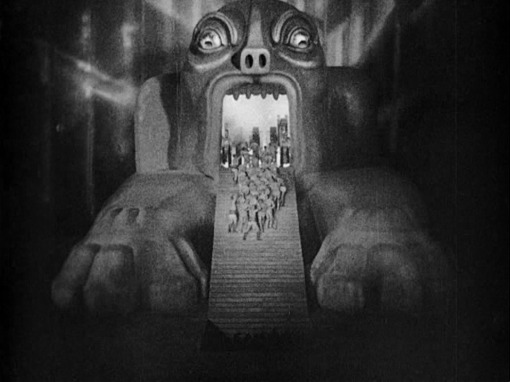 |
| Fig. 1: Original Theatrical Release Poster (1927) |
Fritz Lang's Metropolis (1927) is set in a futuristic
dystopian city that shows dramatically the disparity between those that live in
and enjoy the city, and the workers who keep the city going. ""Metropolis" (1927) fixed for the rest of the
century the image of a futuristic city as a hell of scientific progress and
human despair." (Ebert, 1998)
| Fig. 2: The machine in reality. |
 |
| Fig. 3: The machine as Freder sees it, consuming slaves. |
The film contains masses of imagery. When there is
an explosion at one of the machines (Fig. 2), Freder sees the machine
transform into a monster (Fig. 3); in it's mouth, the churning metal
parts of the machine can be seen, ready to consume the workers who walk into it
in large groups. This idea of the workers being food for the machines is later
reinforced by the Machine-Man who cries "Who is the living food for the
machines in Metropolis -?! Who lubricates the machine joints with their own
blood -?! Who feeds the machines with their own flesh -?!". There is
no question about it, Metropolis is a city built on blood and
bones, something represented by the network of catacombs that lie beneath the
city, completely ignored by the people above, much like the worker city, where
people die but no one hears about it, not even Joh Fredersen, the Master of
Metropolis.
Metropolis shows "a future where an exploited
underclass works in subterranean machine halls to support a small, pampered
aristocracy" (French, 2015). It is representative even of society
today, where so many work in order to keep things moving, while very few do
not, yet live better. It is worth noting, that even when the workers destroy
the machines in order to fight back, it is they who suffer. Their homes are
destroyed in a flood -- one which they believe their children died in too --
while those on the surface enjoy themselves, blissfully ignorant of what is
happening below them.
 |
| Fig. 4: Machine-Man compared to C-3PO |
It is clear from watching Metropolis how the film inspires stories and
character designs to this day. The Machine-Man looks like it could be an
early prototype of C-3PO from Star Wars (1977), the design for the city and
overall story is very similar to the setting in the game BioShock (2007), which is set in an underwater,
dystopian, art deco style city that has been left in ruins after an uprising.
Stories of dystopian cities/towns disguised as utopias have become fairly
common in modern media, to the point where it's almost boring. Watching Metropolis, however, brings
back some of the thrill of watching a city destroyed by its abused
underclass.
 |
| Fig. 5: Fredersen, Rotwang and the Machine-Man |
There is something inspiring about watching a film that paved the way for so many other films, shows, games and books. The world of Metropolis is intriguing and eccentric, yet believable as it represents our own cities and our own culture. It is not hard to imagine Metropolis existing today.
Images:
Figure 1. Original Theatrical Release Poster (1927) Metropolis. [Advertisement] At: https://en.wikipedia.org/wiki/Metropolis_(1927_film) (Accessed on 29.09.15)
Figure 2. Film Still (1927) From: Metropolis. Directed by Fritz Lang. [Film Still]. Germany: Babelsberg Studios. At: http://floatingcinema.info/events/2015/open-air-weekender_humans-in-space-day2 (Accessed on 30.09.15)
Figure 3. Film Still (1927) From: Metropolis. Directed by Fritz Lang. [Film Still]. Germany: Babelsberg Studios. At: https://cinema1544.wordpress.com/cinema-1544/metropolis/ (Accessed on 30.09.15)
Figure 4. Machine-Man Compared to C-3PO. [Image] At: http://starwarsmodern.blogspot.co.uk/2012/11/thoughts-on-episode-vii-learning-from.html (Accessed on 30.09.15)
Figure 5. Film Still (1927) From: Metropolis. Directed by Fritz Lang. [Film Still]. Germany: Babelsberg Studios. At: http://www.datuopinion.com/rotwang (Accessed on 30.09.15)
Bibliography:
Ebert, Roger. (1998) 'Metropolis'. At: http://www.rogerebert.com/reviews/great-movie-metropolis-1927 (Accessed on 29.09.15)
French, Philip. (2015) 'Metropolis review -- Philip French on Fritz Lang's visionary epic'. In: The Guardian [Online] At: http://www.theguardian.com/film/2015/mar/15/metropolis-fritz-lang-philip-french-classic-dvd (Accessed on 29.09.15)

Hi Eleanor,
ReplyDeleteA very thoughtful review - well done.
Just make sure that your font is consistent throughout; in your opening paragraph it is enormous and by the bibliography, I almost needed a magnifying glass to read it :)
And don't forget to italicise those quotes!!
I've tried to go back an edit the font size in the opening paragraph a few times, but for some reason it won't change. I'll try again.
Delete